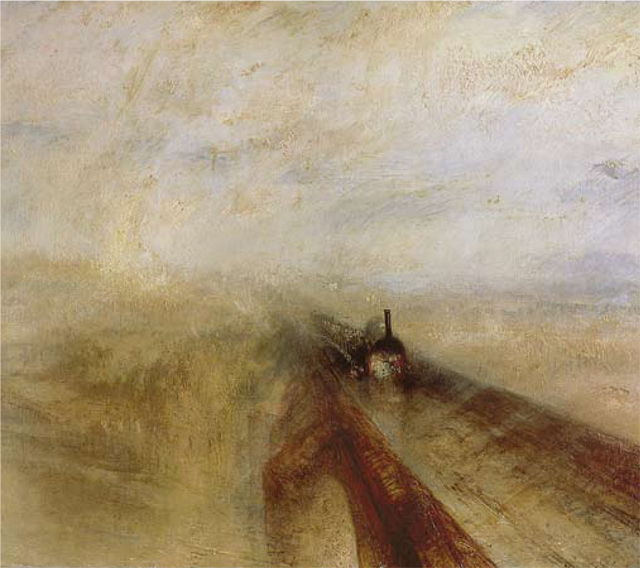My Favourite Painting: Michael Palin
Michael Palin chooses his favourite painting for Country Life.


Rain, Steam, and Speed—the Great Western Railway, 1844, by J. M. W. Turner, National Gallery, London. Bridgeman Images.
Michael Palin says: ‘This is one of the most exciting and significant images of the Industrial Revolution. Above the slow and sylvan world on the banks of the Thames, Change and Progress come thundering along the track towards us. Turner seems to capture not only the sight, but the sound, and even the smell of the Railway Age, after which the British countryside would never be the same again. It’s a painting of tremendous energy and immediacy, which I go back to time and again, always finding something different to admire.’
Michael Palin is an actor, travel writer and television presenter, and a former member of Monty Python. He has recently been elected as president of the Royal Geographical Society.
Art critic John McEwen comments: 'Turner painted mythological pictures and also current events, the first benefiting from his gift for observation, the second from his poetic sense—never more so than in Rain, Steam and Speed, art’s first masterpiece of a train. The site is Brunel’s bridge over the Thames at Maidenhead.
The academician George Leslie watched Turner put the finishing touches at the 1844 RA Summer Exhibition, and recalls the importance to the artist of the barely visible hare out-running the engine. ‘This hare, and not the train, I have no doubt he intended to represent the "Speed" of his title; the word must have been in his mind when he was painting the hare, for close to it, on the plain below the viaduct, he introduced the figure of a man ploughing, "Speed the Plough" (the name of an old country dance) possibly passing through his brain.’
In 1857, six years after Turner’s death, Sir Charles Eastlake, the first keeper of the National Gallery, wrote to a picture cleaner, suggesting that ‘the indication of the speed was marked by three puffs of steam’ and should be ‘assisted a little’ as ‘the traces are still marked by touches of white, but they do not tell’. Some 150 years later, they still do not tell. An etching of the painting by a French artist was hung in tribute at the first exhibition held by the Impressionists in 1874. Monet and Pissarro saw Rain, Steam, and Speed in London, and were inspired to produce their own railway masterpieces. National Gallery, London, UK?'
This article was first published in Country Life, July 29, 2009
Sign up for the Country Life Newsletter
Exquisite houses, the beauty of Nature, and how to get the most from your life, straight to your inbox.
Country Life is unlike any other magazine: the only glossy weekly on the newsstand and the only magazine that has been guest-edited by HRH The King not once, but twice. It is a celebration of modern rural life and all its diverse joys and pleasures — that was first published in Queen Victoria's Diamond Jubilee year. Our eclectic mixture of witty and informative content — from the most up-to-date property news and commentary and a coveted glimpse inside some of the UK's best houses and gardens, to gardening, the arts and interior design, written by experts in their field — still cannot be found in print or online, anywhere else.
-
 RHS Chelsea Flower Show: Everything you need to know, plus our top tips and tricks
RHS Chelsea Flower Show: Everything you need to know, plus our top tips and tricksCountry Life editors and contributor share their tips and tricks for making the most of Chelsea.
By Amie Elizabeth White
-
 Hidden excellence in a £7.5 million north London home
Hidden excellence in a £7.5 million north London homeBehind the traditional façades of Provost Road, you will find something very special.
By James Fisher
-
 My favourite painting: Allan Mallinson
My favourite painting: Allan MallinsonMilitary historian Allan Mallinson picks an image of 'faith, generosity and ultimate sacrifice'.
By Charlotte Mullins
-
 My Favourite Painting: Piet Oudolf
My Favourite Painting: Piet Oudolf'One cannot sense whether he is far out on the ocean or closer to shore, or what he may be watching or feeling in that moment as he stares towards the beach.’
By Country Life
-
 My Favourite Painting: Mary Plazas
My Favourite Painting: Mary Plazas'There is compassion, awe, humility, a knowing yet a questioning in the glistening eyes. It moves me, it inspires me beyond the need to know.’
By Country Life
-
 My favourite painting: Robert Kime
My favourite painting: Robert KimeRobert Kime shares his fondness for New Year Snow by Ravilious
By Country Life
-
 My Favourite Painting: Anna Pavord
My Favourite Painting: Anna PavordAnna Pavord chooses a picture which reminds her of where she grew up
By Country Life
-
 My favourite painting: The Duchess of Wellington
My favourite painting: The Duchess of WellingtonThe Duchess of Wellington chooses her favourite painting for Country Life.
By Country Life
-
 My favourite painting: Maureen Lipman
My favourite painting: Maureen LipmanMaureen Lipman chooses her favourite painting for Country Life.
By Country Life
-
 My favourite painting: Jacqueline Wilson
My favourite painting: Jacqueline Wilson'I looked at this painting and decided to write about a Victorian circus girl one day'
By Country Life